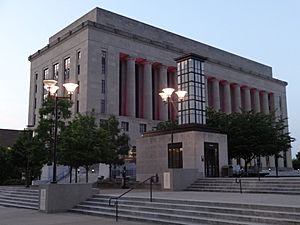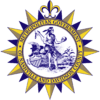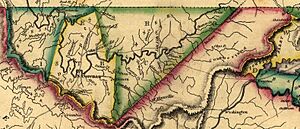Davidson County, Tennessee facts for kids
Quick facts for kids
Davidson County
|
||
|---|---|---|
|
Consolidated city-county
|
||
| Metropolitan Government of Nashville and Davidson County | ||

Davidson County Courthouse
|
||
|
||

Location within the U.S. state of Tennessee
|
||
 Tennessee's location within the U.S. |
||
| Country | ||
| State | ||
| Founded | October 6, 1783 | |
| Named for | William Lee Davidson | |
| Seat | Nashville | |
| Largest city | Nashville | |
| Area | ||
| • Total | 526 sq mi (1,360 km2) | |
| • Land | 504 sq mi (1,310 km2) | |
| • Water | 22 sq mi (60 km2) 4.2% | |
| Population
(2020)
|
||
| • Total | 715,884 | |
| • Estimate
(2023)
|
712,334 |
|
| • Density | 1,361.0/sq mi (525.5/km2) | |
| Time zone | UTC−6 (Central) | |
| • Summer (DST) | UTC−5 (CDT) | |
| Congressional districts | 5th, 6th, 7th | |
Davidson County is a county in the state of Tennessee, USA. It is located in the central part of Tennessee, known as Middle Tennessee. In 2020, about 715,884 people lived here. This makes it the second most populated county in Tennessee.
The main city and county seat of Davidson County is Nashville. Nashville is also the capital city of Tennessee and its biggest city. Since 1963, Nashville and Davidson County have worked together under one government. This is called the "Metropolitan Government of Nashville and Davidson County," or "Metro Nashville." This special setup helps the city and county work as one.
Davidson County is the most populated part of the larger Nashville-Davidson–Murfreesboro–Franklin Metropolitan Statistical Area. Nashville has always been an important center for business, factories, transportation, and culture in the region. It became the permanent capital of Tennessee in 1843.
Contents
Exploring Davidson County's Past
Davidson County is the oldest county in the Middle Tennessee area. It was created in 1783, right after the American Revolution. The county was named after William Lee Davidson. He was a general from North Carolina who died fighting British forces in 1781.
The county seat, Nashville, is the oldest lasting European settlement in Middle Tennessee. It was started by James Robertson and John Donelson in the winter of 1779–80. This was during the final days of the Revolutionary War.
Early Settlers and Native Americans
The first European settlers created the Cumberland Compact. This was a set of rules to help them live together and protect their land. In the early 1780s, these settlers faced challenges from Native American tribes. Tribes like the Cherokee, Muscogee (Creek), and Shawnee used the area for hunting. They were not happy about newcomers moving onto their land.
Native American cultures had lived in Davidson County for thousands of years. Many old archaeological sites show this history. The first white Americans to come to the area were fur traders. Then came "long hunters." They had heard about a large salt lick, called French Lick. Here, they hunted animals and traded with the Native Americans.
In 1765, Timothy Demonbreun, a hunter and trapper, lived in a small cave near what is now downtown Nashville. He and his wife had the first white child born in Middle Tennessee. Many settlers came from Kentucky and other southern states. They grew crops like hemp and tobacco. They also raised high-quality animals, like horses.
How Davidson County Changed Over Time
When Davidson County was first created in 1783, it was much larger. Its original borders covered a huge area. However, over the years, parts of Davidson County were used to create four new counties:
- Sumner County in 1786
- Williamson County in 1799
- Rutherford County in 1803
- Cheatham County in 1856
During the American Civil War in 1861, people in Davidson County voted to leave the United States. The vote was very close. However, the Union Army took control of the county in February 1862. This caused many changes and problems for the area.
Famous People from Davidson County
Many notable people have lived in Davidson County. Here are a few:
- Kizziah J. Bills: A Black American suffragist and civil rights activist. She wrote for Black newspapers in Chicago.
- Newman Haynes Clanton: A cattle rustler and outlaw from the American West.
- Jermain Wesley Loguen: An important leader in the movement to end slavery.
- Benjamin "Pap" Singleton: Another key leader in the movement to end slavery.
Geography and Nature
Davidson County covers about 526 square miles. Most of this is land, with about 22 square miles of water.
The Cumberland River flows through the middle of the county from east to west. There are two dams on the river in the county: Old Hickory Lock and Dam and J. Percy Priest Dam. These dams are managed by the United States Army Corps of Engineers. Other important rivers and creeks in Davidson County include Whites Creek, Manskers Creek, Stones River, Mill Creek, and the Harpeth River.
Neighboring Counties
Davidson County shares borders with several other counties:
- Robertson County, Tennessee – to the north
- Sumner County, Tennessee – to the northeast
- Wilson County, Tennessee – to the east
- Rutherford County, Tennessee – to the southeast
- Williamson County, Tennessee – to the south
- Cheatham County, Tennessee – to the west
Protected Natural Areas
Davidson County has several protected natural areas. These places help keep nature safe.
- Natchez Trace Parkway (part of it)
- Bicentennial Mall State Park
- Couchville Cedar Glade State Natural Area (part of it)
- Harpeth River State Park (part of it)
- Hill Forest State Natural Area
- Long Hunter State Park (part of it)
- Mount View Glade State Natural Area
- Percy Priest Wildlife Management Area (part of it)
- Radnor Lake State Natural Area
Main Roads and Highways
Many important roads and highways pass through Davidson County. These roads connect the county to other parts of Tennessee and the country.
Who Lives in Davidson County?
| Historical population | |||
|---|---|---|---|
| Census | Pop. | %± | |
| 1790 | 3,459 | — | |
| 1800 | 9,965 | 188.1% | |
| 1810 | 15,608 | 56.6% | |
| 1820 | 20,154 | 29.1% | |
| 1830 | 28,122 | 39.5% | |
| 1840 | 30,509 | 8.5% | |
| 1850 | 38,882 | 27.4% | |
| 1860 | 47,055 | 21.0% | |
| 1870 | 62,897 | 33.7% | |
| 1880 | 79,026 | 25.6% | |
| 1890 | 108,174 | 36.9% | |
| 1900 | 122,815 | 13.5% | |
| 1910 | 149,478 | 21.7% | |
| 1920 | 167,815 | 12.3% | |
| 1930 | 222,854 | 32.8% | |
| 1940 | 257,267 | 15.4% | |
| 1950 | 321,758 | 25.1% | |
| 1960 | 399,743 | 24.2% | |
| 1970 | 448,003 | 12.1% | |
| 1980 | 477,811 | 6.7% | |
| 1990 | 510,784 | 6.9% | |
| 2000 | 569,891 | 11.6% | |
| 2010 | 626,681 | 10.0% | |
| 2020 | 715,884 | 14.2% | |
| 2023 (est.) | 712,334 | 13.7% | |
| U.S. Decennial Census 1790–1960 1900–1990 1990–2000 2010–2020 |
|||
The U.S. Census helps us understand the people living in an area. In 2020, there were 715,884 people living in Davidson County. These people lived in about 289,427 households.
Davidson County's Population Mix (2020)
| Group | Number of People | Percentage |
|---|---|---|
| White (not Hispanic) | 386,835 | 54.04% |
| Black or African American (not Hispanic) | 171,489 | 23.95% |
| Native American | 1,309 | 0.18% |
| Asian | 27,660 | 3.86% |
| Pacific Islander | 303 | 0.04% |
| Other/Mixed | 30,169 | 4.21% |
| Hispanic or Latino | 98,119 | 13.71% |
Towns and Neighborhoods
All of Davidson County is part of the "Metropolitan Government of Nashville and Davidson County." However, some towns that existed before this combined government still have some independence.
Independent Towns
These towns have their own local governments:
- Belle Meade
- Berry Hill
- Forest Hills
- Goodlettsville (partly in Sumner County)
- Oak Hill
- Ridgetop (mostly in Robertson County)
The parts of Davidson County that are not in these independent towns are called the "Nashville-Davidson balance" for census purposes.
Nashville Neighborhoods
Many other communities used to be separate towns or unincorporated areas. Now, they are neighborhoods within Nashville. They still keep their unique historical identities.
- Antioch
- Bellevue
- Cane Ridge
- Crieve Hall
- Donelson
- Green Hills
- Hermitage
- Inglewood
- Joelton
- Lakewood
- Madison
- Old Hickory
- Pasquo
- West Meade
- Whites Creek
- Una
Learning in Davidson County
The main school system for the entire county is the Metropolitan Nashville Public School District. This district manages all the public schools.
The Tennessee School for the Blind is also located in Nashville. This is a special school run by the state.
Nature and Wildlife
When the first settlers arrived in the 1770s, Davidson County was full of wildlife. There were many bears, deer, and even buffaloes. These animals provided food for the settlers. Wild cats, wolves, and snakes were also common. Today, many of these wild animals are no longer found in this area.
See also
 In Spanish: Condado de Davidson (Tennessee) para niños
In Spanish: Condado de Davidson (Tennessee) para niños




